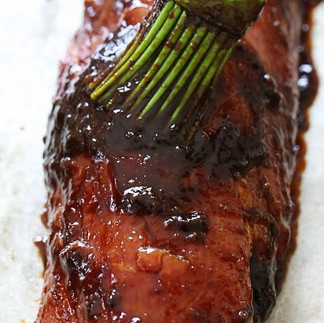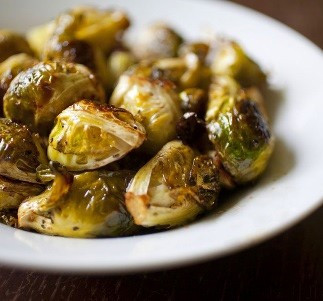
Over the centuries the legend and demand for balsamic vinegar has grown. Everyone wanted a taste of the Ducal balsamico of Renaissance Modena but traditional balsamic vinegar by its very nature could not be rushed and by its standards of production very expensive.
Big food companies responded to the demand for balsamic by adding thickeners and caramel colorants to mimic the look and texture of a traditionally aged balsamic. Labeling became lax and confusing. For a bottle to be labeled “from Modena” only one step in the process had to be performed in Modena and it may only be the bottling. Most people had never tasted the real thing and so did not know what they were missing or what they they were paying for. Some of these vinegars may claim to have been made in Italy, but without a DOP or IGP stamp, the ingredients could come from anywhere and processed far away. The term itself (“aceto balsamico”) is unregulated and often used indiscriminately and therefore misunderstood. Grocery store imitations are far more common than the true balsamic vinegars of Modena and Reggio Emilia.
So what is the best way to buy balsamic? Opinions differ but like any artisan product it begins with the land and the artisan’s hand. Meaning good grapes make good vinegar and authenticity and methods of production drive the passion of the maker and that is what makes a good balsamic.
The methodology of making an authentic balsamic relies on its birth in the barrels used in the aging. In the acetaia (vinegar attic and storeroom) where the air gradually thickens, a young balsamic moves through an organized series of barrels of different sizes and wood types, under the curated care of a master vinegar maker slowly picking up the essences from the wood and the balsamic aromas that have matured together over the centuries. The choice of grapes, the quality of the casks and time are the fundamental ingredients. But it is the master vinegar maker who oversees the evolution of balsamic vinegar, transferring, decanting and refilling the barrels one barrel to the next that determines the true quality of a balsamico. It is generational art, centuries old, which seals the quality and taste of a product capable of defying time. Knowing your producer and buying from a knowledgeable purveyor ensures product provenance. Depending on how you will use your balsamic also determines how you buy it. Our purpose is to offer a good quality balsamic vinegar that can be used and not stored away because there are so many delicious and healthful ways to enjoy this vinegar we want to use it unabashedly.
There are two true balsamic vinegars (cousins if you will) that are regulated by the European Community though a Consortium. A highly aged traditional “tradizionale” balsamic vinegar whose only ingredient is grape must and labeled Aceto Balsamico Tradizionale. It carries a DOP (“Denominazione di Origine Protetta”) stamp, a European Union certification that guarantees an ingredient’s quality, production and place of origin. The other designation of authenticity is the IGP (PGI) stamp (“Indicazione Geografica Protetta”) or protected geographical indication. A good quality IGP balsamic has many of the same flavor profiles as the tradizionale.

IGP balsamic is often made in the same designated place of origin from the same quality ingredients by the same producers who make the higher end tradizionale. Desirous to offer the history and flavor of balsamic to chefs of any ability at a attainable price they combine tradition and innovation for accelerated yet regulated evaporation. Resulting in exceptional IGP balsamic vinegars that are often mistaken for a 10, 12, or even a 15 year old’s that contradict their age and modest price. Their passion and commitment to provide the “ducal” vinegars of Modena and Reggio allows aceto balsamico to be produced in volumes sufficient and at different levels of production to meet demand for everyone’s enjoyment.
Bright and energetic IGP vinegars still have a depth and balsamic personality that make them very sought after and preferred because they are thought by some to be more versatile and multitasking in the kitchen. We offer a balsamic that belies its age and price. One of the best IGP aged balsamic vinegars from Modena you can find. A Sofi™ Gold Award Winner. Well-balanced and versatile with IGP certification produced from Lambrusco and Trebbiano grape must and oak-barrel aged by the Maletti family that has been producing quality Lambrusco wine for generations.
Know Your Source
There are some vinegars that use the word “balsamic” that are really just vinegar with sweetener and coloring. They may be made with wine vinegar, white vinegar, or cider vinegar, and they’re industrially-produced to mimic the texture and flavor of balsamic, at a fraction of the price. Some of these vinegars may claim to have been made in Italy. Without designations there are no guarantees to the method used in the making, the area of production, aging time, quality and value to the consumer. We promote and support generational producers committed to the culinary and cultural heritage of balsamic as regulated by the European Community though the Consortiums. A brotherhood of balsamic whose aim is respect for the traditional manufacturing process while promoting research in the field to ensure high quality in the final product.
Balsamic Glazed Pork Tenderloin

Ingredients and Method
1 pork tenderloin (1 pound)
1 tablespoon minced fresh garlic
1/4 teaspoon sea salt
1/4 teaspoon coarse ground pepper
1 tablespoon extra virgin olive oil
1/2 cup balsamic vinegar
1/2 cup packed brown sugar
Preheat oven to 375°. Make a paste of the minced garlic, salt and pepper and rub the mixture all over the tenderloin. In a large ovenproof skillet, heat oil over medium heat. Brown pork on all sides turning frequently, being careful not to burn the garlic. Remove pork from pan. Remove pan from heat; add balsamic stirring to loosen and deglaze browned bits from pan. Stir in brown sugar. Mix to dissolve. Return pork to pan, turning pork to coat with the deglazed mixture.
Place in oven for 20 minutes or until a thermometer reads 145°, turning occasionally.Spoon a small amount of the glaze on the tenderloin after the first half of the cooking time. When done remove pork to a serving platter; tent with foil. Let stand 5 minutes before slicing. Pour remaining glaze over pork before serving.












Comments